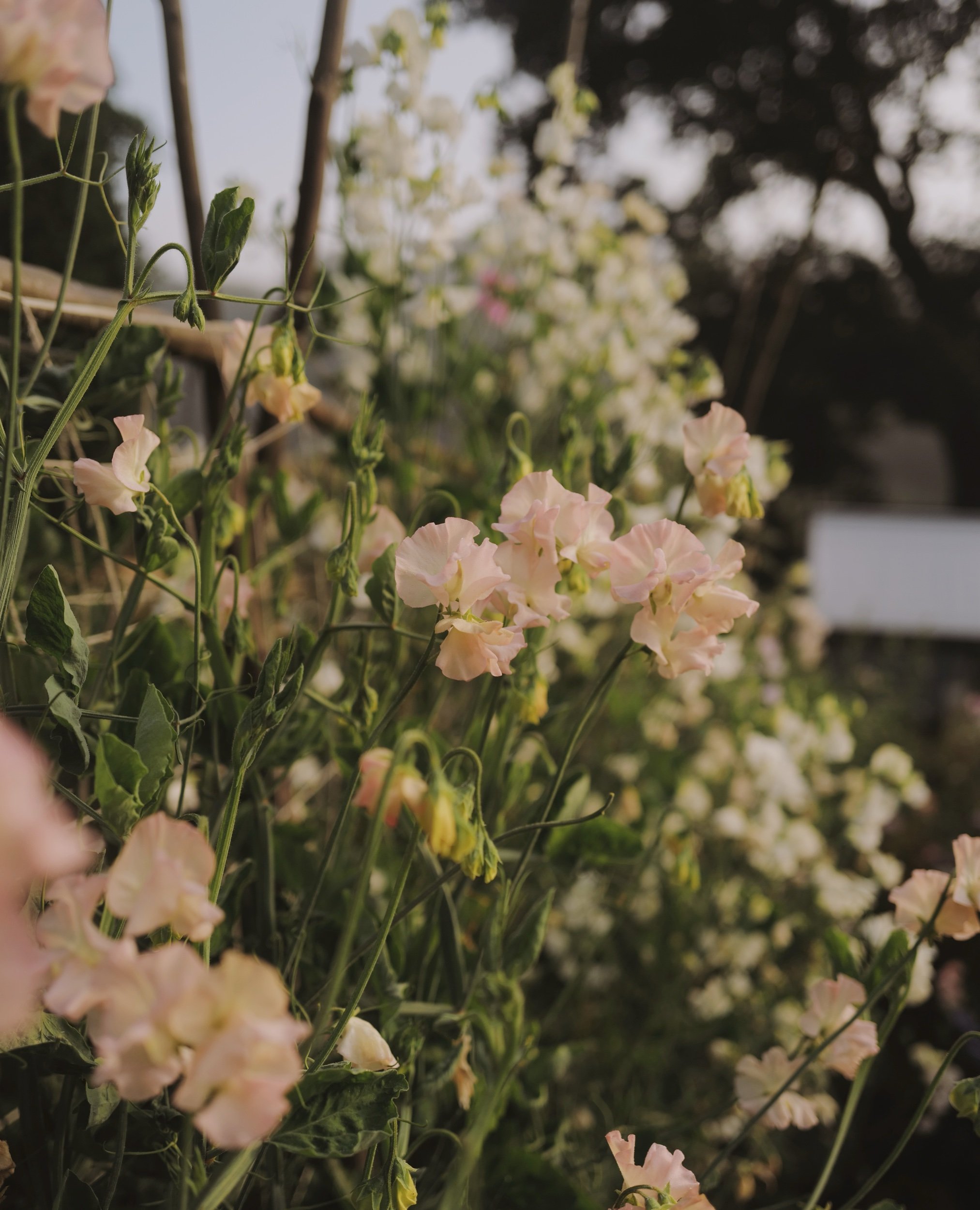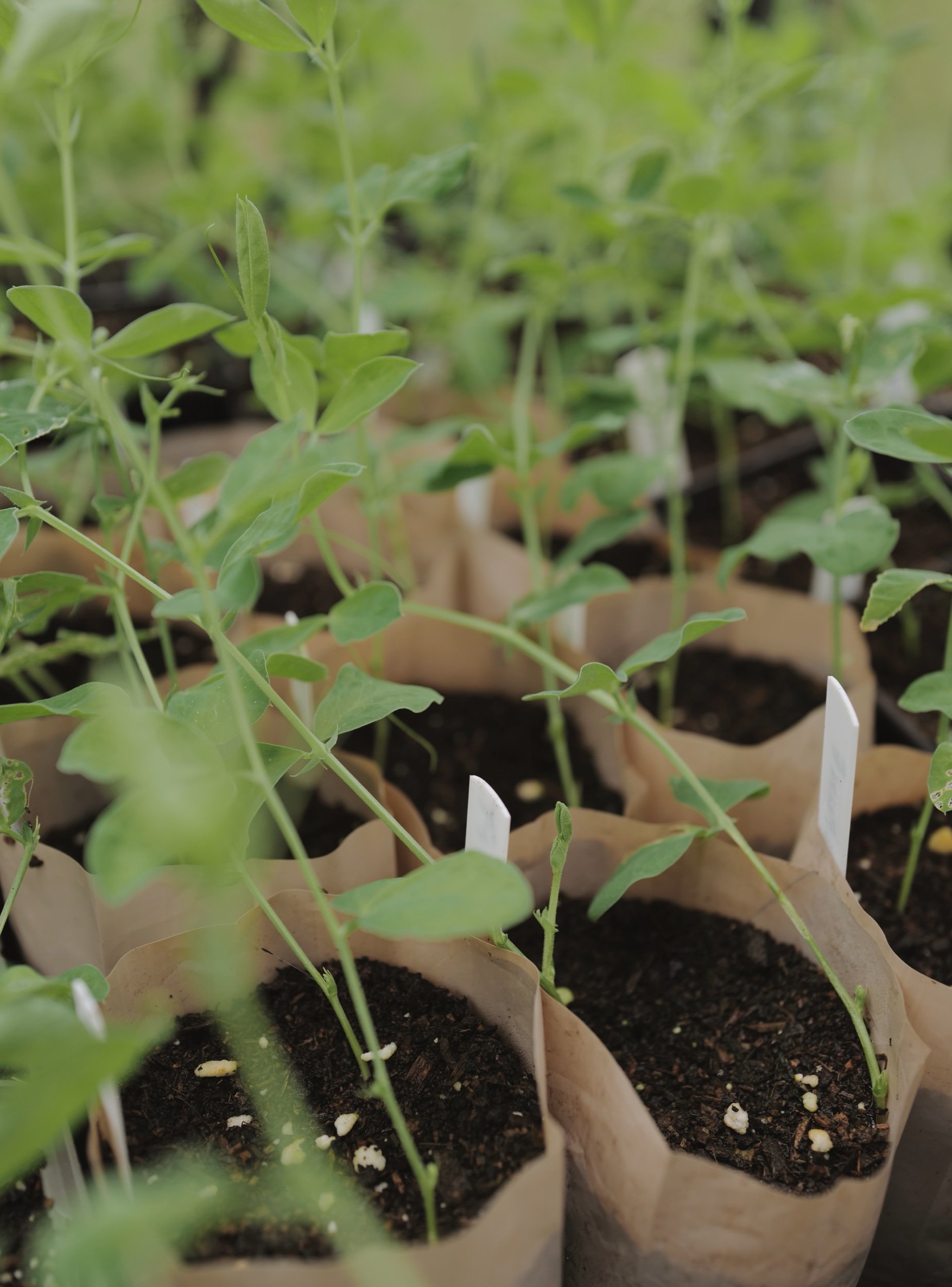Sweet Peas: A Growing Guide - From Seedlings to Blooms
There’s no hiding it- Paris and I are complete sweet pea addicts. We get so much joy from growing these lovely plants. They are straightforward to care for and reward you with so many flowers. We have twenty years experience of growing these beauties between us; I can’t imagine a summer without them.
Once your sweet pea seedlings have germinated and grown strong roots, it is time to focus on their care, planting out, and tying in to ensure they produce the best possible display of flowers throughout the season. Sweet peas thrive with the right support, regular feeding, and thoughtful pruning, so follow these steps to grow healthy, fragrant blooms all summer long.
Sweet Pea Castlewellan
Caring for Sweet Pea Seedlings
1. Keeping Seedlings Cool
Once your sweet peas have germinated, they should be kept in a bright but cool place. If they were grown indoors or in a heated greenhouse, move them to a cold frame, unheated greenhouse, or sheltered outdoor spot to encourage strong root growth.
Sweet peas thrive in cool conditions, and their growth will be slow over winter, focusing on developing deep roots rather than top growth. This is perfectly normal and will help them establish well once planted out.
2. Spring Sown Sweet Peas - Pinching Out for Bushier Growth
We pinch out spring sown sweet peas To encourage strong, bushy plants. We don’t need to with Autumn sown as they branch out naturally. pinch out the central growing tip when the seedlings reach 8–10 cm (3–4 inches) tall and have at least two sets of true leaves. This will promote more side shoots, leading to stronger, multi-stemmed plants with more flowers later in the season. You only need to do this once.
How to pinch: Simply use your thumb and forefinger (or small snips) to remove the very tip of the plant, just above a set of leaves.
Planting Out Sweet Peas
1. When to Plant Out
Autumn-sown sweet peas can be planted out from mid-March onwards, once they are well-established and the worst frosts have passed.
Spring-sown sweet peas can be planted out in April or early May, once they have grown sturdy enough to handle outdoor conditions.
2. Choosing the Right Spot
Sweet peas love full sun and well-drained soil. They can tolerate part shade, and clay soil, too. They will flower best in rich, fertile soil, so prepare the ground well before planting.
Improve the soil by adding well-rotted manure or compost to the planting area.
Good drainage is essential—avoid planting in waterlogged areas.
Sheltered spots with good airflow help prevent diseases like mildew.
3. Spacing & Planting
Space sweet peas 15–20 cm (6–8 inches) apart. We tend to simply plant our 2-3 seedlings growing in the same pot in the same space and then the next pot at 15 cm along. This maximises space and they don’t seem to mind.
Plant at the same depth as in the pot, firm in the soil gently, and water well after planting.
Providing Support for Climbing Sweet Peas
Sweet peas are climbing plants and will need sturdy supports to grow properly. Install your structure before planting so the plants can climb from the start.
Best Supports for Sweet Peas
Teepee style support – Made from bamboo or hazel canes tied at the top. Ideal for growing in groups.
Trellises or netting – Perfect for covering walls, fences, or archways.
Strings on canes – The traditional method used by exhibitors for growing tall, straight stems.
Encourage climbing: Sweet peas climb by tendrils that latch onto supports. If they struggle to attach, gently tie them in with soft twine.
Picture By Eva Nemeth
Watering
Sweet peas need regular watering, especially once they start to grow rapidly.
Water deeply at least once a week in dry weather.
If growing in pots, check daily—potted sweet peas dry out faster.
Mulching with compost or leaf mould can help retain moisture and suppress weeds.
Encouraging Continuous Flowering
The key to prolonging the flowering season is to keep picking the blooms. Cut first thing in the morning, or in the evening when the flowers are naturally more hydrated. Cut and put straight into clean water. You’ll get the longest vase life from flowers that still have a floret or two closed.
Deadheading & Cutting for Bouquets
Regular picking encourages more flowers. If left to go to seed, sweet peas will stop flowering. We find the most efficient, most productive way to do this is to cut every flower we can see once a week.
Remove any faded flowers, too (deadheading) to prevent seed pods from developing.
Preventing Common Problems
Mildew: Ensure good airflow, avoid overhead watering, and water at the base of the plant.
Aphids: Rinse off with water or use watered down washing up liquid soap if needed.
Slugs & Snails: These can be such a problem with young sweet pea growth. Once they are mature they are less inclined to much them. Protect young seedlings by placing them out of slugs and snails reach. Only plant out when your plants have a good root system (when the roots have reached the bottom of your 9cm pots), that way they’ll have a good chance of bouncing back even if they do get nibbled when planted out.
Sweet Pea Juliet
Enjoying Your Sweet Peas
With the right care, sweet peas will reward you with months of fragrant, beautiful flowers. Their delicate blooms, cascading tendrils, and incredible scent make them one of the most joyful plants to grow—whether for cutting, training up arches, or simply enjoying in the garden.
Sweet Pea Juliet





